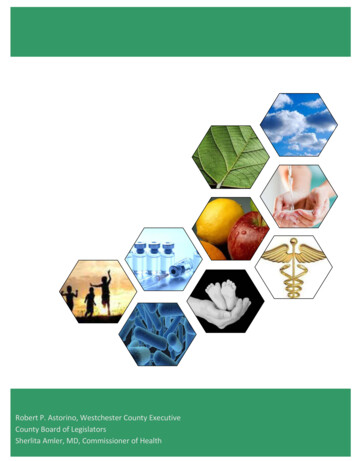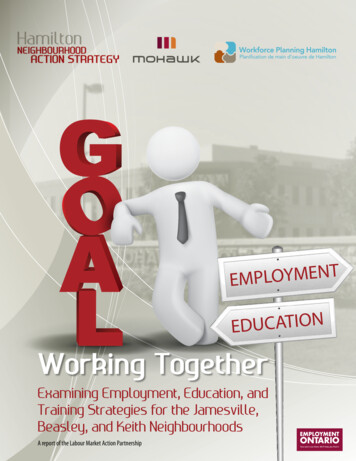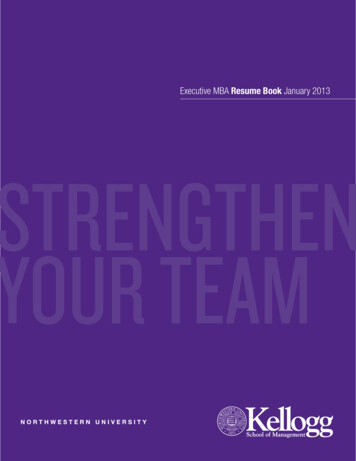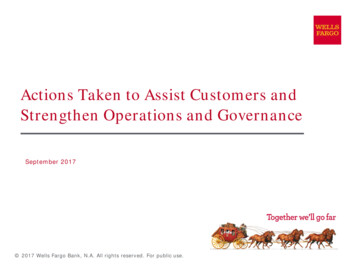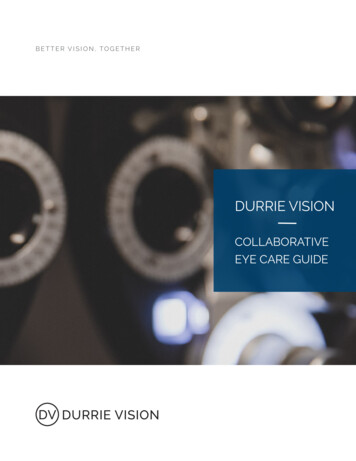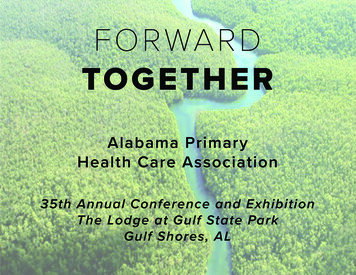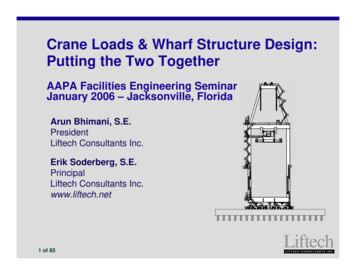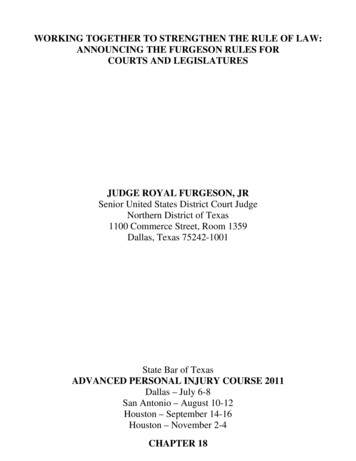
Transcription
WORKING TOGETHER TO STRENGTHEN THE RULE OF LAW:ANNOUNCING THE FURGESON RULES FORCOURTS AND LEGISLATURESJUDGE ROYAL FURGESON, JRSenior United States District Court JudgeNorthern District of Texas1100 Commerce Street, Room 1359Dallas, Texas 75242-1001State Bar of TexasADVANCED PERSONAL INJURY COURSE 2011Dallas – July 6-8San Antonio – August 10-12Houston – September 14-16Houston – November 2-4CHAPTER 18
JUDGE ROYAL FURGESONSenior United States District Judge1100 Commerce Street / Dallas, TX 75242-1310Ph: 214-753-2355 / Fax: 214-753-2356PERSONAL: Wife: Marcellene Malouf, Executive Director, DII Asbestos Trust, Dallas, TX Children: Kelly, Houston, Josh, Seth and Jill; Stepchildren: Christina, Elizabeth, Katherine and JonathanEMPLOYMENT: U.S. Army from 1967-69 (attained rank of Captain; served year in Vietnam). Clerk for Honorable Halbert O. Woodward, U. S. District Judge, Lubbock, Texas, 1969-70. Shareholder, Law Firm of Kemp, Smith, Duncan & Hammond, El Paso, Texas, 1970-94. U. S. District Judge, Western District of Texas: El Paso Division, March 11, 1994 to March 1995; MidlandDivision, March 1995 to March 2003; San Antonio Division, March 2003 to November 2008. Senior U. S. District Judge, Northern District of Texas, December 2008 to present.EDUCATION: B.A. Degree, English, May 1964, Texas Tech University (Varsity Letter, Basketball, 1961-62; Student Body Pres.,1963-64) J.D. Degree with Honors, May 1967, University of Texas School of Law (Associate Editor, Texas Law Review)AFFILIATIONS: Board Certified, Texas Board of Legal Specialization, Civil Trial Law, 1979-94. Texas Bar Foundation, 1981-present. American Law Institute, 1982-present. American College of Trial Lawyers, 1987-present. American Bar Foundation, 1993-present. Philosophical Society of Texas, 2000 to present.ACTIVITIES: El Paso County Child Welfare Board (Chair, 1977-78). University of Texas Law Alumni Association (President, 1978-1979). National Conference of Christians and Jews, El Paso Chapter (President 1978). El Paso United Way (General Campaign Chair 1979 and President 1981). El Paso Cancer Treatment Center (President 1980). El Paso Bar Association (President 1983). Keep El Paso Beautiful Association (President 1988). American Board of Trial Advocates, El Paso Chapter (President 1991). Judicial Resources Committee of the Judicial Conference of the United States (Chair 2005-2007). Judicial Panel on Multidistrict Litigation (2008-present). Federal Judges Association (President, 2011-13) Judicial Branch Committee of the Judicial Conference of the United States (2011-Present)RECOGNITION: Outstanding Young Lawyer of El Paso, 1973. Faculty Award, University of Texas Law School, 1983. Humanitarian Award, National Jewish Center for Immunology & Respiratory Medicine, 1988. Hannah G. Solomon Award, El Paso Section, National Council of Jewish Women, 1991. Community Service Award, University of Texas School of Law, 1991. Honorary Degree, Cathedral High School, El Paso, Texas, 1994. Outstanding Jurist Award, El Paso Bar Association, 1996. Leon Green Award, Texas Law Review, University of Texas School of Law, 2001. Nancy L. Garms Memorial Award, State Bar of Texas, 2003. Spirit of Excellence Award, American Bar Association, Commission on Racial and Ethnic Diversity, 2004. Judicial Appreciation Award, San Antonio Young Lawyers’ Association, 2004. Jurist of the Year, Texas Chapter of the American Board of Trial Advocates, 2004. Distinguished Alumnus, Texas Tech Alumni Association, 2007. West Texas Legal Legend, Texas Tech University School of Law, 2008. Standing Ovation Award, State Bar of Texas CLE, 2009. State Bar of Texas Antitrust and Business Litigation Section “2010 Distinguished Counselor” Award State Bar of Texas Litigation Section “Luke Soules” Award, 2011
Working Together To Strengthen The Rule Of LawChapter 18TABLE OF CONTENTSI.INTRODUCTION. 1II.THE RULE OF LAW: DEFINING AN “EXCEEDINGLY ELUSIVE NOTION” . 2A. The rule of law requires accountability for all persons—including the government. . 31.2.3.B.The rule of law requires not only laws be available to the public, but also laws beunderstandable and stable. . 61.2.3.C.Courts must do a better job of preserving accountability (The Furgeson Rule for Courts). . 3Legislatures must not shield entire groups from accountability, at the cost of citizens(The Furgeson Rule for Legislatures). . 4Accountability is not the enemy of national security. . 5The rise of electronic legal information informs the public and, in turn, strengthensthe rule of law. . 6Laws must provide transparency to the public. . 6A lack of emphasis on civil education leaves the general populace without the toolsto protect the rule of law. . 7The rule of law requires that citizens have access to the courts. . 71.2.3.The legislature limits access. . 7The legal push for arbitration limits access. . 8Through judicial activism, the courts limit access. 9D. The rule of law requires that the public trust its judicial system; a trust hard earned withoutindependence and diversity in the judiciary. . 101.2.The rule of law is weakened when the public believes that its judiciary isbeholden to campaign contributors. . 10A judiciary that fails to reflect the population it serves undermines the rule of law. . 11III. CONCLUSION . 12POWERPOINT PRESENTATION . 13i
Working Together to Strengthen the Rule of LawChapter 1832 state court systems saw reductions in theirfunding?6 What does it mean when judicial vacanciesin the federal courts constantly number above 100?7It means the rule of law in America is in trouble.While we as lawyers and judges are certain of thecrucial importance of the rule of law in our democracy,our fellow citizens are not so sure and that is a problemof existential proportions. Francis Fukuyama hasexplained why. To Dr. Fukuyama the rule of law is notonly the foundation of democracy but also the strengthof modern society and an advantage that democracieshave over authoritarian forms of government. In Dr.Fukuyama’s view, poor countries suffer “because theylack effective political institutions.” Indeed, theabsence of a strong rule of law, in his view, is "one ofthe principal reasons why poor countries can’t achievehigher rates of growth.”8Long before Dr. Fukuyama, the Founders of ournation well understood the need for the rule of law. AsAlexander Hamilton wrote in The Federalist No. 78,limitation on the government “can be preserved inpractice no other way than through the medium ofcourts of justice, whose duty it must be to declare allacts contrary to the manifest tenor of the Constitutionvoid. Without this, all the reservations of particularrights or privileges would amount to nothing.”9Indeed, as our nation must understand, without thelaw, there is no justice and without justice, there is noliberty. To put it another way, without the rule of law,there can be no democracy and no civil society. Thus,not just America, but any nation, to be free, mustembrace the rule of law. Yet, if a nation’s people donot comprehend the existential importance of the law,then can that nation exist for long as both just and free?America must never get to the precipice of such aquestion.This Article will suggest a workable-yetcomprehensive definition of the rule of law. Then,though certainly not all-inclusive, the Article addressescurrent examples of both threats to and protections ofthe rule of law. In sum, the Article strives toencourage thoughtful evaluation and discussion of theWORKING TOGETHER TOSTRENGTHEN THE RULE OF LAW:ANNOUNCING THE FURGESONRULES FOR COURTS ANDLEGISLATURESEconomic growth, political modernization, theprotection of human rights, and other worthyobjectives are all believed to hinge, at least inpart, on ‘the rule of law.’ 1I.INTRODUCTIONIn the closing verses of Ecclesiastes, we areinstructed that, in times of difficulty, the “silver cord”can be loosened.2 In America, our “silver cord” is therule of law. It must be maintained and cannot beloosened, regardless of the difficult days ahead. Yet,there are indications that all is not well.For example, what does it mean when only 30%of Americans know that the Constitution is thesupreme law of the land?3 What does it mean whenonly 54% of American students agree that newspapersshould be allowed to publish freely withoutgovernment approval?4 What does it mean when amajority of California’s voters think that the best placeto cut spending is the courts and the state judiciary?5What does it mean when, during the 2010 fiscal year,* The author acknowledges the substantial assistance ofKrystal Scott, one of my outstanding former law clerks, inpreparing this Article. Kristina Kiik, presently a law clerk,and Erin Higginbotham, immediate past law clerk, alsomade thoughtful contributions. Adan Briones, Lara Pringle,and Katherine Brooker provided able assistance as well.Finally, special thanks to Judy Way for her help and patiencein the preparation of this Article.1The World Bank, The Rule of Law as a Goal ofDevelopment Policy, http://www.worldbank.org.2Ecclesiastes 12:1-6 (“Remember your Creator before thesilver cord is loosed, Or the golden bowl is broken, Or thepitcher shattered at the fountain, Or the wheel broken at thewell.”).6Karen Weise, What’s on the Docket? Backlogs andLayoffs, BLOOMBERG BUSINESSWEEK, May 2-8, 2011, at 25(citing the National Center for State Courts).3Andrew Romano, How Dumb Are We?, NEWSWEEK, Apr.4, 2011, at 56, 59.7DRI-THE VOICE OF THE DEFENSE BAR, WITHOUT FEAR ORFAVOR IN 2011 A NEW DECADE OF CHALLENGES TOJUDICIAL INDEPENDENCE AND ACCOUNTABILITY 70 i.org/contentdirectory/public/reports/ WithoutFear-or-Favor-2011.pdf.4Future of the First Amendment 2007 Follow-Up Survey:Key Findings ‘07, JOHN S. AND JAMES L. KNIGHTFOUNDATION, 23 (Sept. 17, 2007), .pdf.5Mark DiCamillo and Mervin Field, Voters Express Viewson Dealing with the State’s Huge Budget Deficit, THE FIELDPOLL, 7 (Mar. 16, 2011) available at ls2368.pdf.8Nicholas Wade, From ‘End of History’ Author, a Look atthe Beginning and Middle, N.Y. TIMES, Mar. 8, 2011, at D3.91THE FEDERALIST NO. 78 (Alexander Hamilton).
Working Together to Strengthen the Rule of LawChapter 18rule of law, to the end that steps be taken to strengthenit.have developed their own definitions of the rule of law,with varying degrees detail.16In this vein, two recent definitions of the rule oflaw warrant particular attention as both comprehensiveand constructive. First, the United States Departmentof State and the United States Agency for InternationalDevelopment jointly developed the followingdefinition for use in justice-sector foreign assistanceprograms:II. THE RULE OF LAW: DEFINING AN“EXCEEDINGLY ELUSIVE NOTION”The rule of law has evolved, but has never falteredin its underlying maxim: No one is immune to the lawand no one can be punished by the government exceptfor a breach of the law. The concept’s inception iscredited to Aristotle, who claimed that “it is moreproper that law should govern than any one of thecitizens.”10 In 1215, King John placed England’ssovereigns (at least partially) within the rule of lawwhen he signed the Magna Carta:“Rule of law” is a principle under which allpersons, institutions and entities, public andprivate, including the State itself, areaccountable to laws that are publiclypromulgated,equallyenforced,independently adjudicated, and consistentwith international human rights principles.17No freemen shall be taken or imprisoned ordisseised or exiled or in any way destroyed,nor will we go upon him nor send upon him,except by the lawful judgment of his peers orby the law of the land.11The American Bar Association has developed adefinition that is equally robust:However, the phrase “rule of law” was not popularizeduntil 1885 by A.V. Dicey, a British jurist.12 And acrossthe pond, Thomas Paine made the idea a matter ofcommon sense when he asserted, without hesitation,that “In America, the law is king.”13Described as “an exceedingly elusive notion,” therule of law has challenged legal minds for centuries.14Legal theorists debate the rule of law’s characteristics.Some believe that the rule of law must entail somebasic elements—a public declaration that embodiesgenerality, equality, and certainty, but no particularcontent. Others believe that the rule of law mustinclude specific protection of individual rights.15 In themidst of the debate, national and global groups alike10ARISTOTLE, THE POLITICS Book 3.16.11Magna Carta, art. 29 (1215).12A.V. DICEY, THE LAWed. 1915).OF THECONSTITUTION,CH.16See, e.g., Kaufman, Daniel et al. Governance Matters VI:Governance Indicators for 1996-2006 (World Bank PolicyResearch Working Paper No. 4280),avaliable athttp://ssrn.com/abstract 999979 (defining the rule of law as:"the extent to which agents have confidence and abide by therules of society, and in particular the quality of contractenforcement, the police and the courts, as well as thelikelihood of crime or violence."); What is the Rule of Law?,UNITED NATIONS RULE OF LAW, http://www.unrol.org/article.aspx?article id 3 (“a principle of governance inwhich all persons, institutions and entities, public andprivate, including the State itself, are accountable to lawsthat are publicly promulgated, equally enforced andindependently adjudicated, and which are consistent withinternational human rights norms and standards .”);FRANCIS NEATE, RULE OF LAW ACTION GROUP,RESOLUTION OF THE COUNCIL OF THE INTERNATIONAL BARASSOCIATION OF OCTOBER 8, 2009, ON THE COMMENTARYON RULE OF LAW RESOLUTION (2005) (2009), available mentUid 9925C6FD-5804-407F-9D39-ECB9D6A8B9D44 (8thBRIAN Z. TAMANAHA, ON THE RULE OF LAW 9 (2004) (theterm “rule of law” gives rise to a “rampant divergence ofunderstandings.”).(endorsing a substantive definition of the rule of law andstating that “the rule of law is the foundation of a civilizedsociety. It establishes a transparent process accessible andequal to all. It ensures adherence to principles that bothliberate and protect”); MARK AGRAST, ET AL., THE WORLDJUSTICE PROJECT, WJP RULE OF LAW INDEX (2010)(advancing a rule of law concept with four universalprinciples and a ten-factor index to measure adherence tothese principles).151713THOMAS PAINE, COMMON SENSE AND OTHER POLITICALWRITINGS 32 (Nelson F. Adkins ed., 9th prtg. 1976) (1975);see also Marbury v. Madison, 5 U.S. (1 Cranch) 137, 163(1803) (Marshall, J.) (America is “emphatically [a nation] oflaws . . . and not of men.”).14Brian Z. Tamanaha, The Rule of Law for Everyone? 55CURRENT LEGAL PROBLEMS 97 (2002) (explaining that thesetwo theories are called, respectively, the formal andsubstantive approaches).US DEP’T OF STATE & US AGENCY FOR INT’L DEV.,STANDARDIZED PROGRAM STRUCTURE AND DEFINITIONS on/141836.pdf.2
Working Together to Strengthen the Rule of Law1.2.3.4.Chapter 18A system of self-government inwhich all persons, including thegovernment, are accountable underthe law;A system based on fair, publicized,broadly understood and stable laws;A robust and accessible process inwhich rights and responsibilitiesbased in law are impartiallyenforced; andDiverse, competent, independent,and ethical lawyers and judges.18Therefore, it is submitted that the courts mustalways rule in such a way to preserve accountability,when at all possible. Unfortunately, there are too manyinstances where courts fail to do so.To better focus the courts on this principle, a newrule of jurisprudence is suggested: “In reaching a finalresult, a court should always consider if its ruling onthe law fosters accountability or erodes accountability.If it erodes accountability, the court should think longand hard about all other possible alternatives.” Thisrule of jurisprudence is hereby called the FurgesonRule for Courts21.It is submitted that, in civil cases, there are threeelements of accountability. The first element is legalaccountability, which requires that everyone isaccountable under the law. The Furgeson Rule isdirected toward legal accountability, which is adecision for the court. The second element is factualaccountability. Whether a person, a corporation, or thegovernment is individually accountable depends on thefacts. Under our system, deciding factualaccountability traditionally has been assigned to thejury. The third element is proportionate accountability.If a person, a corporation, or the government is heldaccountable under the law and the facts, then the extentof the accountability depends on the degree of harmcaused. Again, traditionally, this decision rests with thejury.To illustrate the potential impact of the FurgesonRule, it is helpful to examine a recent decision from theU.S. Supreme Court, AT&T Mobility v. Concepcion.22The case involved an attempt by an AT&T customer tobring a class action suit for fraud, alleging that AT&Tcharged sales tax on “free phones.” The telephonecontract between the parties required mandatoryarbitration of all disputes and prohibited class-widearbitration. AT&T moved to compel arbitration underthe contract and the lower courts refused to do so,finding that the provision prohibiting class-widearbitration was unconscionable under California lawand determining that the Federal Arbitration Act didnot preempt state law because Section 2 of the Actexcepts from arbitration “such grounds as exist at lawor in equity for the revocation of any contract.”23These definitions share a focus on the four keyelements of a healthy rule of law: (1) broad-basedaccountability; (2) publicly available laws; (3) equalaccessibility; and (4) an autonomous judiciary. Inshort, accountability, availability, accessibility, andautonomy. Utilizing these four elements, one candivine instances in our own nation where the rule oflaw is being impeded and impaired.A.The rule of law requires accountability for allpersons—including the government.If men were angels, no government would benecessary. In framing a government which isto be administered by men over men, thegreat difficulty lies in this: you must firstenable the government to control thegoverned; and in the next place oblige it tocontrol itself. 191.Courts must do a better job of pr
JUDGE ROYAL FURGESON Senior United States District Judge 1100 Commerce Street / Dallas, TX 75242-1310 Ph: 214-753-2355 / Fax: 214-753-2356 PERSONAL:

